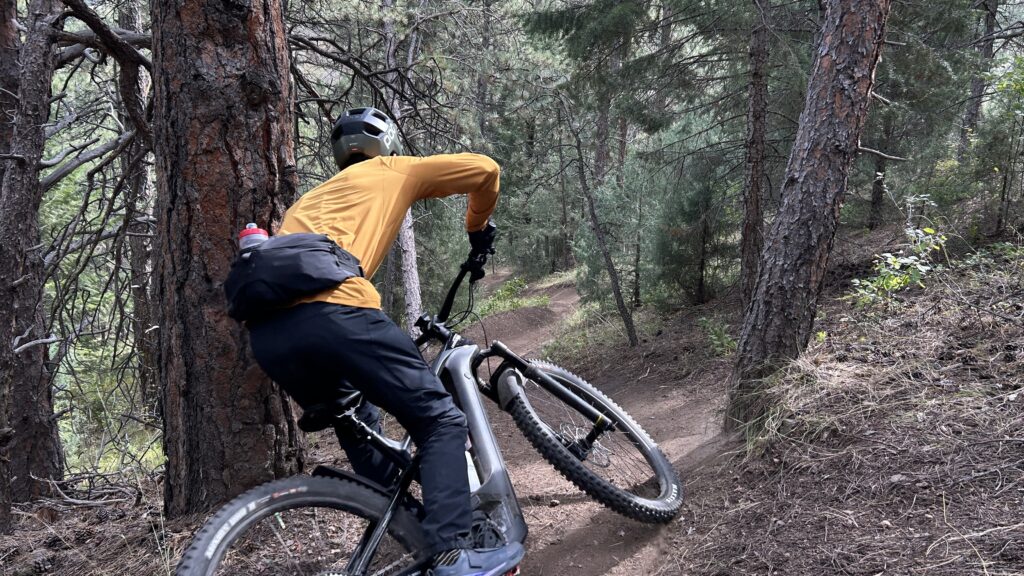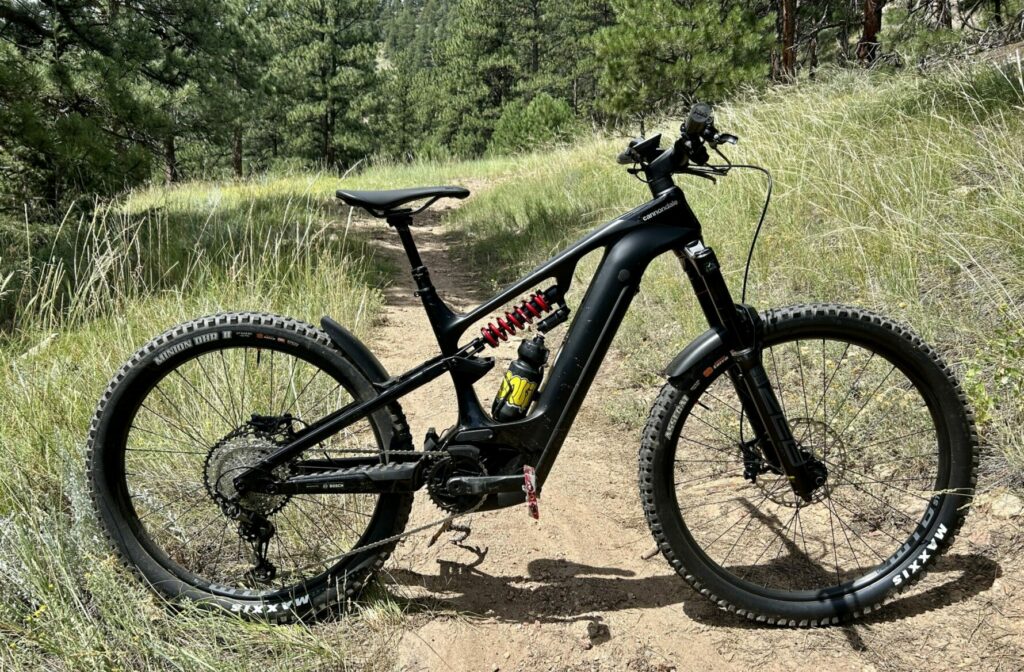Verbal meme: It’s the “Predator” handshake, where Arnold is on one side, Carl Weathers is on the other, both all sweaty and muscle-bound. Remember that one? Okay, that’s mountain bike technology and motorcycle technology. I’m not sure which one gets killed at the end of the movie.

Now that I’ve either lost or confused everyone, the point of this article: Motorcycles have had different front and rear wheel sizes for decades. Mountain bikes only started doing this a few years ago. Weird. So many other moto technologies translated much quicker — suspension, hydraulic disc brakes, tubeless, and more.
Perhaps there will always be holdouts in the myriad conventional mountain bike categories. Cross-country racing with a small rear wheel would be a bummer. But for my money, nearly every e-MTB will soon sport a 27.5” rear wheel and a 29” front. It offers the best combination of handling and performance. Here’s why it will become the standard.
How Mullet Wheels Affect E-Bike Handling
This summer, I sold my Santa Cruz Megatower (29” wheels front and rear), and swapped to two test e-MTBs, a Cannondale Moterra Neo LT Carbon and a Specialized Turbo Levo Comp Carbon.
All three of these bikes are in the same ballpark in terms of suspension travel, geometry, and intended use. You shouldn’t need me to tell you how different the conventional Megatower is from the e-bikes, though. The Moterra and Levo are each 50+ pounds — two-thirds more than the Megatower. And yet, I never struggled to muscle the e-bikes through corners.
Mullet wheels, people.
With a smaller rear wheel, both of the test bikes were willing participants when it was time to weave through trees, transition quickly from berm to berm, or even pop off of jumps and features. Having a 27.5” out back just makes the handling feel a lot tighter and tidier. It responds quickly to input. You’re not fighting such a large gyroscope to lean it over. Once I was accustomed to either bike, the thought of a smaller rear wheel completely left my mind because it just handled intuitively.
Up front, a large-and-in-charge 29” wheel skips across all but the deepest troughs and bumps, reminding me once again why this is the preferred wheel size for nearly every mountain bike.

Mullet Wheels and E-MTB Performance
The funny thing about the moto vs. bike comparison is that, unlike most other components and technologies, the mullet wheel advantages don’t exactly translate to bikes, even e-bikes.
One of the main reasons that motorcycles use smaller rear wheels is to allow for much larger rear tires for traction, since they’re being driven with a motor that measures output in horsepower, not watts. A four-inch wide rear tire would be prohibitively heavy on an e-bike, and it would also make frame design very difficult.
However, there is another benefit to the smaller rear wheel that does apply to e-bikes: A smaller wheel accelerates quicker.
A bit of that comes down to weight and inertia. A lot of it comes down to the physics of torque — rotational force. If the motor is driving the hub of a 27.5” wheel, it has to overcome a smaller lever (i.e., radius) to accelerate, compared to a 29” wheel.
This advantage is more pronounced when a pedal-assist motor is delivering an extra 450 watts. Since you aren’t applying that kind of power on a conventional bike (or if you are, look into the Olympics), the acceleration affect of mixed wheel sizes isn’t as drastic, which probably explains why only 23.7% of people who took the recent Vital gear survey said their next bike would have mixed wheel sizes. With e-bike power, though, it is an advantage to run a smaller rear wheel. I’d say it is noticeable, although not as meaningful as the handling gains covered above.
Downsides of Mullet Wheels on E-Bikes
Right out of the gate, I’ve told you this wheel standard will be the standard for e-mountain bikes. It’s not without its quirks and particularities, though.
Chief among my complaints is how the smaller wheel affects the bike’s balance on steep climbs. Yes, we all love how the mullet wheels position us for steep descents, myself included. But e-MTBs encourage you to climb tough trails too, and the smaller rear wheel takes more of your weight off of the front wheel, resulting in vague steering and potentially even a loop-out if you aren’t on top of things. This issue is exaggerated by slack geometry. A lower handlebar position improves things but doesn’t totally eliminate the problem.
The second concern I have with the smaller rear wheel is how it seems to get hung up on extremely chunky descents. While a full 29er monster-trucks through all manner of detritus, the slightly smaller diameter wheel wants to be floated over the worst sections. If not, it feels like it is bleeding your momentum on rough bits. My solution to this has been running CushCore inserts and lower pressure, but that too is only a half-measure.
Conclusion
I almost hope I am wrong, and that the industry continues to offer an array of 29” e-MTBs. I’m curious to see if they can find a way to make them work well for this application, so we’d have the option. It would make for a pretty interesting comparison.
Earlier this year, I rode a Specialized Turbo Levo SL, which had full 29” wheels. I only had it for a weekend, so I hesitate to make a strong point here, but I will say I remember it requiring a bit more input in corners, despite being about 10 pounds lighter. That could be the centrifugal force produced by a larger rear wheel.
Physics speculation aside, the latest Levo SL has mullet wheels. That says a lot more about mixed wheel sizes and e-bikes than I ever could! Thank you, Specialized engineers.
On the whole, I am willing to cope with a few of the minor downsides to enjoy the handling and performance that’s on the table with mixed wheel-sizes. E-bikes are different from conventional bikes in two major ways: They weigh significantly more, and they produce significantly more power. From what I’ve seen, running a smaller rear wheel compensates for both of those factors in quite an elegant way.
